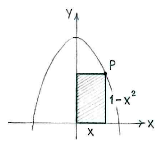Lösung 1.3:4
Aus Online Mathematik Brückenkurs 2
K |
K (Robot: Automated text replacement (-{{Displayed math +{{Abgesetzte Formel)) |
||
| Zeile 5: | Zeile 5: | ||
The area of the rectangle is then given by | The area of the rectangle is then given by | ||
| - | {{ | + | {{Abgesetzte Formel||<math>A(x) = \text{(base)}\cdot\text{(height)} = x\cdot (1-x^2)</math>}} |
and we will try to choose <math>x</math> so that this area function is maximised. | and we will try to choose <math>x</math> so that this area function is maximised. | ||
| Zeile 21: | Zeile 21: | ||
We must therefore conclude that the maximum area is a critical point. We differentiate | We must therefore conclude that the maximum area is a critical point. We differentiate | ||
| - | {{ | + | {{Abgesetzte Formel||<math>A'(x) = 1\cdot (1-x^2) + x\cdot (-2x) = 1-3x^2\,,</math>}} |
and the condition that the derivative should be zero gives that <math>x=\pm 1/\!\sqrt{3}</math>; however, it is only <math>x=1/\!\sqrt{3}</math> which satisfies <math>0\le x\le 1</math>. | and the condition that the derivative should be zero gives that <math>x=\pm 1/\!\sqrt{3}</math>; however, it is only <math>x=1/\!\sqrt{3}</math> which satisfies <math>0\le x\le 1</math>. | ||
| Zeile 27: | Zeile 27: | ||
At the critical point, the second derivative <math>A''(x)=-6x</math> has the value | At the critical point, the second derivative <math>A''(x)=-6x</math> has the value | ||
| - | {{ | + | {{Abgesetzte Formel||<math>A''\bigl( 1/\!\sqrt{3}\bigr) = -6\cdot\frac{1}{\sqrt{3}} < 0\,,</math>}} |
which shows that <math>x=1/\!\sqrt{3}</math> is a local maximum. | which shows that <math>x=1/\!\sqrt{3}</math> is a local maximum. | ||
| Zeile 33: | Zeile 33: | ||
The answer is that the point <math>P</math> should be chosen so that | The answer is that the point <math>P</math> should be chosen so that | ||
| - | {{ | + | {{Abgesetzte Formel||<math>P = \Bigl(\frac{1}{\sqrt{3}}, 1-\Bigl(\frac{1}{\sqrt{3}} \Bigr)^2\, \Bigr) = \Bigl(\frac{1}{\sqrt{3}}, \frac{2}{3} \Bigr)\,\textrm{.}</math>}} |
Version vom 12:56, 10. Mär. 2009
If we call the x-coordinate of the point \displaystyle P \displaystyle x, then its y-coordinate is \displaystyle 1-x^{2}, because \displaystyle P lies on the curve \displaystyle y=1-x^{2}.
The area of the rectangle is then given by
| \displaystyle A(x) = \text{(base)}\cdot\text{(height)} = x\cdot (1-x^2) |
and we will try to choose \displaystyle x so that this area function is maximised.
To begin with, we note that, because \displaystyle P should lie in the first quadrant, \displaystyle x\ge 0 and also \displaystyle y=1-x^2\ge 0, i.e. \displaystyle x\le 1. We should therefore look for the maximum of \displaystyle A(x) when \displaystyle 0\le x\le 1\,.
There are three types of points which can maximise the area function:
- critical points,
- points where the function is not differentiable,
- endpoints of the region of definition.
The function \displaystyle A(x) = x(1-x^2) is differentiable everywhere, so item 2 does not apply. In addition, \displaystyle A(0) = A(1) = 0\,, so the endpoints in item 3 cannot be maximum points (but rather the opposite, i.e. minimum points).
We must therefore conclude that the maximum area is a critical point. We differentiate
| \displaystyle A'(x) = 1\cdot (1-x^2) + x\cdot (-2x) = 1-3x^2\,, |
and the condition that the derivative should be zero gives that \displaystyle x=\pm 1/\!\sqrt{3}; however, it is only \displaystyle x=1/\!\sqrt{3} which satisfies \displaystyle 0\le x\le 1.
At the critical point, the second derivative \displaystyle A''(x)=-6x has the value
| \displaystyle A''\bigl( 1/\!\sqrt{3}\bigr) = -6\cdot\frac{1}{\sqrt{3}} < 0\,, |
which shows that \displaystyle x=1/\!\sqrt{3} is a local maximum.
The answer is that the point \displaystyle P should be chosen so that
| \displaystyle P = \Bigl(\frac{1}{\sqrt{3}}, 1-\Bigl(\frac{1}{\sqrt{3}} \Bigr)^2\, \Bigr) = \Bigl(\frac{1}{\sqrt{3}}, \frac{2}{3} \Bigr)\,\textrm{.} |

